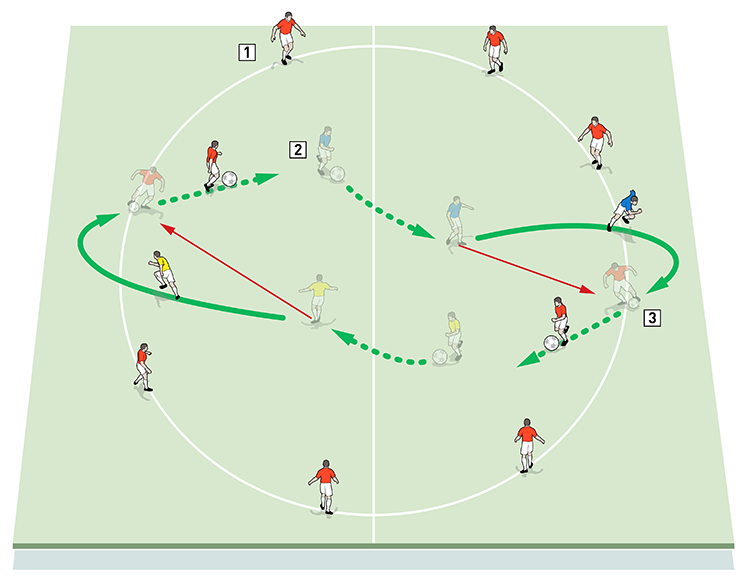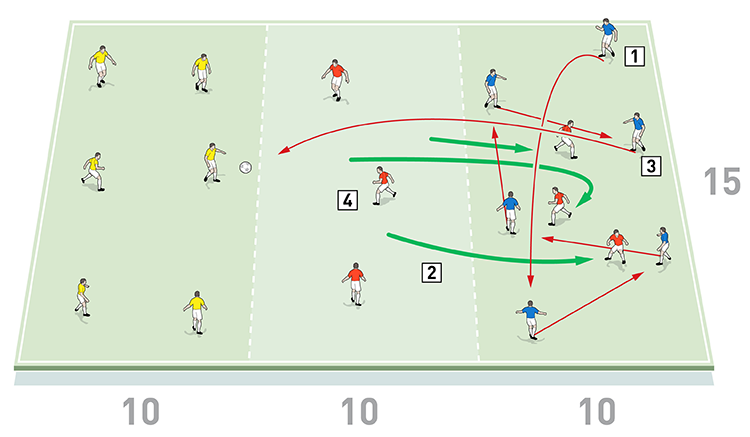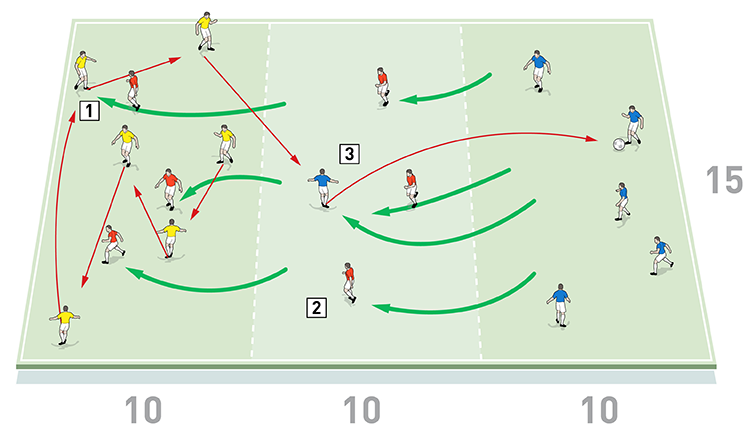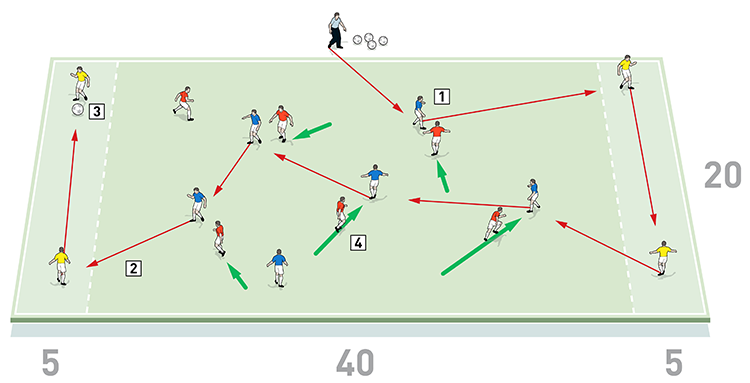Playing through the midfield

| Area | Up to 50x20 yards |
| Equipment | Balls, bibs, cones |
| No. of Players | Up to 18 players |
| Session Time | Technical warm-up: 8mins, Possession game: 20mins, Passing forward: 20mins |
This session is all about playing through the midfield. Its aim is to develop a team’s ability to maintain possession and improve the timing, quality and weight of passing. It also works on communication between the different units.
This is a training session that I have run for several years. With a slight variation it can be used for all age groups, from young players through to seniors. It can be used as part of the academy curriculum or as team planning, from the learning patterns of juniors through to running it with the senior first team players to ensure they understand their roles and responsibilities.
TECHNICAL WARM-UP
We set up in the centre circle. We’re using 10 players, with eight players around the edge of the circle and two players in the centre. Each of the two players in the centre starts with a ball. They both dribble across the circle and then pass to an outside player, changing places with the player they passed to. The receiving player must then dribble across the circle before passing to another outside player and switching places with them, as shown [1].
1

2. Two players start inside the circle. Each has a ball. They dribble and then pass to an outside player, changing places with the receiving player
3. The receiving player must then dribble across the circle before passing to another outside player and switching places
This technical warm-up gives the players plenty of touches of the ball and will help them to work on their ball manipulation skills before the main part of the session begins. We would usually play this warm-up for eight minutes.
POSSESSION GAME
We run this game to set the theme for the session. We set up in a playing area of 30x15 yards, divided into three 10-yard zones. We’re using 18 outfield players, split into three teams of six. One team starts in each end zone and the remaining team starts in the central zone.
Play starts with one of the end zone teams passing the ball to keep possession. As soon as the ball is live, the team in the central zone sends three players into the end zone to try and win the ball in a 6v3.
The possession team must make five consecutive passes before they can switch play to the other end, as shown [2a], and the three remaining defending players in the central zone should try to screen the forward pass and stop it if they can.
2a

2. The red team in the central zone sends three players into the end zone to try and win the ball from the blues
3. The possession team must make five passes before they can play forward to the other end
4. The three remaining reds in the central zone should try to screen the forward pass
If they fail to stop the pass, the three players in the central zone follow the ball and go and press the new possession team in the other end zone, while the three original pressers recover back into the central zone.
If the pressing players win the ball they keep it and their team mates join them in the end zone that possession was given away, with the team that lost the ball going into the central zone and sending three players to press.
We can progress the activity so a player from the opposite end zone to the ball can drop into the central zone and receive to play forward, as shown [2b].
2b

2. The three original red pressers recover back into the central zone
3. Progress the activity so a blue player from the opposite end zone to the ball can drop into the central zone and receive to play forward
PASSING FORWARD
We set up in a playing area of 50x20 yards, including 5-yard end zones at each end. We’re using 16 outfield players, split into two teams of six and one team of four. Two players from the team of four start in each end zone and the two teams of six play 6v6 in the central area.
Play starts with the coach serving into one of the teams in the central area. The team in possession must pass the ball and try to transfer it from one end to the other under pressure from the pressing team. If they succeed in working it from end to end they score a point.
When an end zone player receives the ball he must switch the play in two touches, passing to his team mate in the same end zone before the ball can be played back into the central area, as shown [3].
3

2. The team in possession must transfer the ball from one end to the other to score a point
3. When an end zone player receives the ball he must use just two touches to switch the play to his team mate before it can be played back to the possession team
4. The out-of-possession team presses to win the ball. If they win the ball, they pass to an end zone player and become the new possession team
If the pressing team wins the ball, they must pass to an end zone player and then they become the new possession team when the ball is played back. They then have to work it from end to end to score a point.
What are the typical mistakes players might make and how do I avoid them?
Players tend to enjoy this session but mistakes can happen, with players making the wrong decisions and using incorrect movement. However, we try to encourage the players to experiment with their play, as the more confident they become in training, the more likely they are to try these things out in matches.
How would I put this in a game situation?
We would finish the session with a 9v9 scenario-based game [not shown]. We would allow the players to get together to choose the scenario and then watch to see if they could put into practice what they had learnt from the session.
We would look for players to make good movement off the ball to create space and open passing lines, and to use accurate and well timed passes. We would also hope to see good combination play and teams showing they can keep possession long enough to create an opening to play forward through midfield.
Editor's Picks
Attacking transitions
Deep runs in the final third
Using the goalkeeper in build-up play
Intensive boxes drill with goals
Penetrating the final third
Creating and finishing
My philosophy
Pressing initiation
Compact team movement
Coaches' Testimonials

Alan Pardew

Arsène Wenger

Brendan Rodgers

Carlos Carvalhal

José Mourinho

Jürgen Klopp

Pep Guardiola

Roy Hodgson

Sir Alex Ferguson

Steven Gerrard
Coaches' Testimonials

Gerald Kearney, Downtown Las Vegas Soccer Club

Paul Butler, Florida, USA

Rick Shields, Springboro, USA

Tony Green, Pierrefonds Titans, Quebec, Canada
Join the world's leading coaches and managers and discover for yourself one of the best kept secrets in coaching. No other training tool on the planet is written or read by the calibre of names you’ll find in Elite Soccer.
In a recent survey 92% of subscribers said Elite Soccer makes them more confident, 89% said it makes them a more effective coach and 91% said it makes them more inspired.
Get Monthly Inspiration
All the latest techniques and approaches
Since 2010 Elite Soccer has given subscribers exclusive insight into the training ground practices of the world’s best coaches. Published in partnership with the League Managers Association we have unparalleled access to the leading lights in the English leagues, as well as a host of international managers.
Elite Soccer exclusively features sessions written by the coaches themselves. There are no observed sessions and no sessions “in the style of”, just first-hand advice delivered direct to you from the coach.









